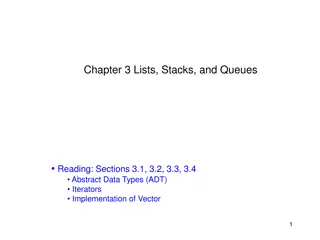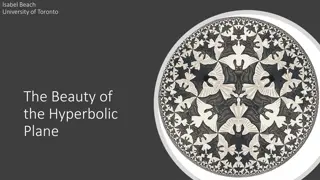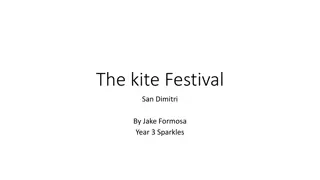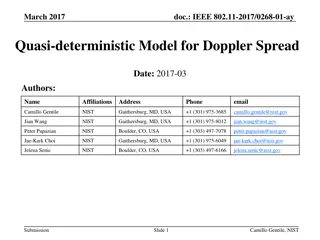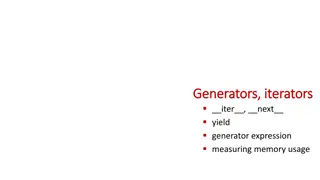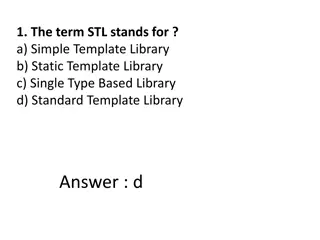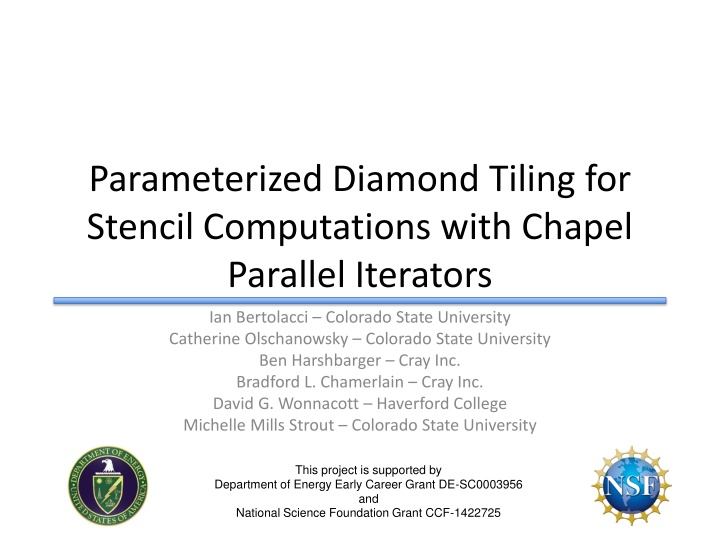
Parameterized Diamond Tiling for Stencil Computations in Chapel
This project explores the development of efficient and adaptable code for high-performance computing using parameterized diamond tiling with Chapel parallel iterators. It addresses the challenges in software engineering for performance-driven code and the evolution of hardware systems. The research showcases the potential to create code that is both performant and easily adaptable to future computing systems, focusing on stencil computations for various applications such as partial differential equation solvers, fluid flow simulation, and seismic wave modeling.
Download Presentation

Please find below an Image/Link to download the presentation.
The content on the website is provided AS IS for your information and personal use only. It may not be sold, licensed, or shared on other websites without obtaining consent from the author. If you encounter any issues during the download, it is possible that the publisher has removed the file from their server.
You are allowed to download the files provided on this website for personal or commercial use, subject to the condition that they are used lawfully. All files are the property of their respective owners.
The content on the website is provided AS IS for your information and personal use only. It may not be sold, licensed, or shared on other websites without obtaining consent from the author.
E N D
Presentation Transcript
Parameterized Diamond Tiling for Stencil Computations with Chapel Parallel Iterators Ian Bertolacci Colorado State University Catherine Olschanowsky Colorado State University Ben Harshbarger Cray Inc. Bradford L. Chamerlain Cray Inc. David G. Wonnacott Haverford College Michelle Mills Strout Colorado State University This project is supported by Department of Energy Early Career Grant DE-SC0003956 and National Science Foundation Grant CCF-1422725
HPC is a Software Engineering Nightmare Performance code is a nightmare to develop. Hardware is evolving rapidly. Can your software be easily adapted to perform on the next big system? Our work demonstrates that it is possible to develop code that is performant and adaptable. Parameterized Diamond Tiling Chapel iterators as tiling schedule abstraction 1
Chapel Programming Language A new parallel programming language Design and development led by Cray Inc. Initiated under the DARPA HPCS program Overall goal: Improve programmer productivity Improve the programmability of parallel computers Match or beat the performance of current programming models Support better portability than current programming models Improve the robustness of parallel codes 2
Target: Stencil Computations Partial Differential Equation solvers Air and fluid flow simulation Seismic wave models and damage simulation Blast-wave equations Heat equations Atmospheric modeling Magnetic field simulations 3
Stencil Computations t [x,y] t-1 [x,y-1] [x+1,y] [x,y] [x-1,y] [x,y+1] 4
Stencil Computations t [x+1,y] t-1 5
Stencil Computations C + OpenMP: Chapel: 6
Stencil Computations C + OpenMP: A[t][x][y]=( A[t-1][x-1][y] + A[t-1][x][y-1] + A[t-1][x+1][y] + A[t-1][x][y+1] + A[t-1][x ][y] )/5; Chapel: A[t,x,y]=( A[t-1, x-1, y] + A[t-1, x, y-1] + A[t-1, x+1, y] + A[t-1, x, y+1] + A[t-1, x , y] )/5; 7
Stencil Computations C + OpenMP: for( int x = 1; x <= N; x += 1 ) for( int y = 1; y <= M; y += 1 ) A[t][x][y]=( A[t-1][x-1][y] + A[t-1][x][y-1] + A[t-1][x+1][y] + A[t-1][x][y+1] + A[t-1][x ][y] )/5; Chapel: for (x,y) in {1..N, 1..M} do A[t,x,y]=( A[t-1, x-1, y] + A[t-1, x, y-1] + A[t-1, x+1, y] + A[t-1, x, y+1] + A[t-1, x , y] )/5; 8
Stencil Computations C + OpenMP: for( int t = 1; t <= T; t += 1 ) for( int x = 1; x <= N; x += 1 ) for( int y = 1; y <= M; y += 1 ) A[t][x][y]=( A[t-1][x-1][y] + A[t-1][x][y-1] + A[t-1][x+1][y] + A[t-1][x][y+1] + A[t-1][x ][y] )/5; Chapel: for t in 1..T do for (x,y) in {1..N, 1..M} do A[t,x,y]=( A[t-1, x-1, y] + A[t-1, x, y-1] + A[t-1, x+1, y] + A[t-1, x, y+1] + A[t-1, x , y] )/5; 9
Stencil Computations C + OpenMP: for( int t = 1; t <= T; t += 1 ) #pragma omp parallel for for( int x = 1; x <= N; x += 1 ) for( int y = 1; y <= M; y += 1 ) A[t][x][y]=( A[t-1][x-1][y] + A[t-1][x][y-1] + A[t-1][x+1][y] + A[t-1][x][y+1] + A[t-1][x][y] )/5; Chapel: for t in 1..T do forall (x,y) in {1..N, 1..M} do A[t,x,y]=( A[t-1, x-1, y] + A[t-1, x, y-1] + A[t-1, x+1, y] + A[t-1, x, y+1] + A[t-1, x , y] )/5; 10
Stencil Computations Na ve parallelization performance does not scale with additional cores! Bandwidth-bound computation. Na ve parallelism under utilizes the memory- hierarchy. 11
Traditional Solution: Space Tiling Group spatial iterations together to reuse shared input data No reuse of just-computed values. 6 3 8 1 2 7 5 4 4 1 2 7 3 8 5 6 12
Modern Solution: Diamond Tiling [Bandishi et al. SC12] Mixes space and time tiling A single tile will perform multiple time steps Reuse just-computed values t+3 t+2 t+1 t 13
Modern Solution: Diamond Tiling [Bandishi et al. SC12] Mixes space and time tiling A single tile will perform multiple time steps Reuse just-computed values t+3 t+2 t+1 t 14
Modern Solution: Diamond Tiling [Bandishi et al. SC12] Mixes space and time tiling A single tile will perform multiple time steps Reuse just-computed values Concurrent Startup Many tiles can start in parallel
Modern Solution: Diamond Tiling [Bandishi et al. SC12] t x 16
Modern Solution: Diamond Tiling [Bandishi et al. SC12] t x 17
Software Engineering Limitations Code generation requires a constant tile size. Severely complicates application portability. Must generate different code for each tile size that s optimal for different stencils within application. Lengthens performance profiling process. Generated code is not human friendly Multiple stencil-computations results in chains of convoluted loop nests. Difficult to modify, debug, and improve. 18
Technical Contributions Parameterized Diamond Tiling Demonstration of Chapel iterators as effective tiling schedule deployment mechanism 19
Parameterized Diamond Tiling Uppert Lowert Upperx Lowerx Tile Size (Tau) 20
Parameterized Diamond Tiling Uppert (2*tau+k0*tau+k1*tau-1)/2 (k0+tau+k1*tau)/2 Lowert Upperx Lowerx (tau+tau*k0 tau*k1)/2 (tau*k0 tau-tau*k1)/2 21
Parameterized Diamond Tiling Upperx Lowerx 22 Lx (tau*k0 tau-tau*k1)/2 (tau+tau*k0 tau*k1)/2 Ux
Parameterized Diamond Tiling Uppert (k0+tau+k1*tau)/2 Ut Lt (2*tau+k0*tau+k1*tau-1)/2 Lowert 23
Parameterized Diamond Tiling Generalizable to higher dimensionality, different tiling hyperplanes. Paper presents methodology to do this by hand. 24
Generated Code C + OpenMP: for (kt=ceild(3,tau)-3; kt<=floord(3*T,tau); kt++) { int k1_lb = ceild(3*Lj+2+(kt-2)*tau,tau*3); int k1_ub = floord(3*Uj+(kt+2)*tau,tau*3); int k2_lb = floord((2*kt-2)*tau-3*Ui+2,tau*3); int k2_ub = floord((2+2*kt)*tau-3*Li-2,tau*3); #pragma omp parallel for for (k1 = k1_lb; k1 <= k1_ub; k1++) { for (x = k2_lb; x <= k2_ub; x++) { k2 = x - k1; for (t = max(1, floord(kt*tau-1, 3)); t < min(T+1, tau + floord(kt*tau, 3)); t++) { write = t & 1; read = 1 - write; for (x = max(Li,max((kt-k1-k2)*tau-t, 2*t-(2+k1+k2)*tau+2)); x <= min(Ui,min((1+kt-k1-k2)*tau-t-1, 2*t-(k1+k2)*tau)); x++) { for (y = max(Lj,max(tau*k1-t, t-i-(1+k2)*tau+1)); y <= min(Uj,min((1+k1)*tau-t-1, t-i-k2*tau)); y++) { A[write][x][y] = ( A[read][x-1][y] + A[read][x][y-1]+ A[read][x+1][y] + A[read][x][y+1]+ A[read][x ][y] )/5; } } } } } } Tile Wave-fronts Tile Coordinates Time-Steps in Tile Read/Write buffer X,Y Coordinates Stencil Operation 25
Generated Code Chapel: for kt in -2 .. floord(3*T,tau) { var k1_lb: int = floord(3*Lj+2+(kt-2)*tau,tau_times_3); var k1_ub: int = floord(3*Uj+(kt+2)*tau-2,tau_times_3); var k2_lb: int = floord((2*kt-2)*tau-3*Ui+2,tau_times_3); var k2_ub: int = floord((2+2*kt)*tau-2-3*Li,tau_times_3); forall k1 in k1_lb .. k1_ub { for x in k2_lb .. k2_ub { var k2 = x-k1; for t in max(1,floord(kt*tau,3)) .. min(T,floord((3+kt)*tau-3,3)){ Tile Wave-fronts Tile Coordinates Time-Steps in Tile write = t & 1; read = 1 - write; for x in max(Li,(kt-k1-k2)*tau-t,2*t-(2+k1+k2)*tau+2)) .. min(Ui,min((1+kt-k1-k2)*tau-t-1, 2*t-(k1+k2)*tau)) { Read/Write buffer X,Y Coordinates for y in max(Lj,tau*k1-t,t-x-(1+k2)*tau+1) .. min(Uj,(1+k1)*tau-t-1,t-x-k2*tau){ A[write,x,y]=( A[read, x-1, y] + A[read, x, y-1]+ A[read, x+1, y] + A[read, x, y+1]+ A[read, x , y] )/5; } } } } } } Stencil Operation 26
Chapel Iterators iter my_iter( N: int ): int { for i in 1..N do yield i; for i in N..1 by -1 do yield i; } for j in my_iter( 10 ) do writeln( j ); 27
Iterator Abstraction Chapel iter DiamondTileIterator( lowerBound: int, upperBound: int, T: int, tau: int, param tag: iterKind): 4*int where tag == iterKind.standalone { for kt in -2 .. floord(3*T,tau) { var k1_lb: int = floord(3*Lj+2+(kt-2)*tau,tau_times_3); var k1_ub: int = floord(3*Uj+(kt+2)*tau-2,tau_times_3); var k2_lb: int = floord((2*kt-2)*tau-3*Ui+2,tau_times_3); var k2_ub: int = floord((2+2*kt)*tau-2-3*Li,tau_times_3); forall k1 in k1_lb .. k1_ub { for x in k2_lb .. k2_ub { var k2 = x-k1; for t in max(1,floord(kt*tau,3)) .. min(T,floord((3+kt)*tau-3,3)){ for kt in -2 .. floord(3*T,tau) { var k1_lb: int = floord(3*Lj+2+(kt-2)*tau,tau_times_3); var k1_ub: int = floord(3*Uj+(kt+2)*tau-2,tau_times_3); var k2_lb: int = floord((2*kt-2)*tau-3*Ui+2,tau_times_3); var k2_ub: int = floord((2+2*kt)*tau-2-3*Li,tau_times_3); forall k1 in k1_lb .. k1_ub { for x in k2_lb .. k2_ub { var k2 = x-k1; for t in max(1,floord(kt*tau,3)) .. min(T,floord((3+kt)*tau-3,3)){ write = t & 1; read = 1 - write; for x in max(Li,(kt-k1-k2)*tau-t,2*t-(2+k1+k2)*tau+2)) .. min(Ui,min((1+kt-k1-k2)*tau-t-1, 2*t-(k1+k2)*tau)) { .. min(Ui,min((1+kt-k1-k2)*tau-t-1, 2*t-(k1+k2)*tau)) { read = 1 - write; for x in max(Li,(kt-k1-k2)*tau-t,2*t-(2+k1+k2)*tau+2)) write = t & 1; for y in max(Lj,tau*k1-t,t-x-(1+k2)*tau+1) .. min(Uj,(1+k1)*tau-t-1,t-x-k2*tau){ A[write,x,y]=( A[read, x-1, y] + A[read, x, y-1]+ A[read, x+1, y] + A[read, x, y+1]+ A[read, x , y] )/5; } } } } } } } } } } } } } for y in max(Lj,tau*k1-t,t-x-(1+k2)*tau+1) .. min(Uj,(1+k1)*tau-t-1,t-x-k2*tau){ yield (read, write, x, y); 28
Reduction of Code Complexity Without Iterator With Iterator for kt in -2 .. floord(3*T,tau) { var k1_lb: int = floord(3*Lj+2+(kt-2)*tau,tau_times_3); var k1_ub: int = floord(3*Uj+(kt+2)*tau-2,tau_times_3); var k2_lb: int = floord((2*kt-2)*tau-3*Ui+2,tau_times_3); var k2_ub: int = floord((2+2*kt)*tau-2-3*Li,tau_times_3); forall k1 in k1_lb .. k1_ub { for x in k2_lb .. k2_ub { var k2 = x-k1; for t in max(1,floord(kt*tau,3)) .. min(T,floord((3+kt)*tau-3,3)){ forall (read, write, x ,y) in DiamondTileIterator(L, U, T, tau) { A[write, x, y] = ( A[read, x-1, y] + A[read, x, y-1] + A[read, x, y ] + A[read, x+1, y] )/5; } A[read, x, y+1] + write = t & 1; read = 1 - write; for x in max(Li,(kt-k1-k2)*tau-t,2*t-(2+k1+k2)*tau+2)) .. min(Ui,min((1+kt-k1-k2)*tau-t-1, 2*t- (k1+k2)*tau)) { for y in max(Lj,tau*k1-t,t-x-(1+k2)*tau+1) .. min(Uj,(1+k1)*tau-t-1,t-x-k2*tau){ A[write,x,y]=( A[read, x-1, y] + A[read, x, y-1]+ A[read, x+1, y] + A[read, x, y+1]+ A[read, x , y] )/5; } } } } } } 29
Metrics of Success Parameterized Diamond Tiling is competitive with fixed size Diamond Tiling. Chapel iterator performance is competitive with C + OpenMP implementation. 30
Methodology Hardware: Workstation Machine Single socket Intel Xeon E5 8 Core (16 Hyper-Threads) 2.6GHz 32Kb L1 data, 256Kb L2, 20Mb L3 Cache 32 Gb RAM Benchmarks: Jacobi 1D & 2D Problem sizes 2x L3 cache 31
Parameterized vs Fixed Tile Sizes Parameterized tile size does better than fixed. 32
Competitive Performance Maximum Speedup: Chapel: 8.4x C + OpenMP: 8.5x 33
Competitive Performance Maximum Speedup: Chapel: 6.7x C + OpenMP: 6.4x 34
Conclusion Parameterized tile size Diamond Tiling is just as effective as fixed tile size Diamond Tiling. Diamond Tiling implemented in Chapel iterators is competitive with Diamond Tiling in C + OpenMP. Chapel iterators make advanced tiling schedules much easier to adopt and use. 35

